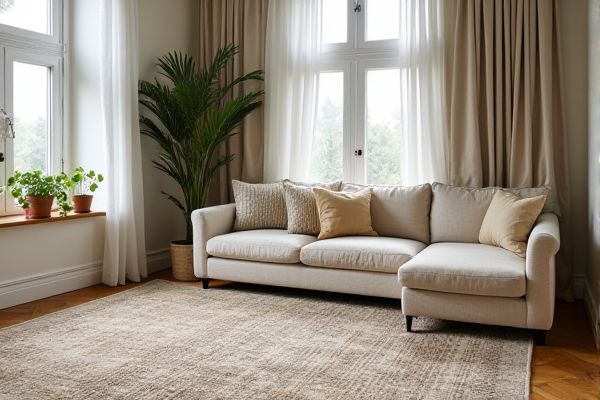
Fiber rugs offer natural texture and durability, often made from materials like wool or jute, providing a cozy and eco-friendly option for your home. Nylon rugs excel in stain resistance and resilience, making them ideal for high-traffic areas where longevity is key; discover more to find which rug suits your needs best.
Table of Comparison
| Feature | Fiber Rug | Nylon Rug |
|---|---|---|
| Material | Natural fibers (wool, cotton, jute) | Synthetic polymer (nylon) |
| Durability | Moderate; may wear with heavy use | High; resistant to abrasion and heavy traffic |
| Stain Resistance | Low to moderate; natural fibers absorb stains | High; nylon repels stains effectively |
| Maintenance | Requires gentle cleaning; professional care recommended | Easy to clean; machine washable or spot clean |
| Texture | Soft, warm, natural feel | Smooth, resilient, slightly synthetic feel |
| Cost | Higher price range; depends on fiber quality | Affordable to mid-range pricing |
| Eco-Friendliness | Biodegradable and sustainable | Non-biodegradable; petroleum-based material |
| Color Retention | Moderate; natural fibers may fade over time | Excellent; nylon holds vibrant colors well |
Introduction to Fiber Rugs and Nylon Rugs
Fiber rugs, typically made from natural materials like wool, jute, or sisal, offer eco-friendly durability and a textured, organic aesthetic ideal for cozy and rustic interiors. Nylon rugs are synthetic, prized for their resilience, stain resistance, and vibrant color retention, making them suitable for high-traffic areas and modern home settings. Both fiber and nylon rugs provide distinct benefits in terms of material composition, maintenance, and visual appeal, catering to different lifestyle needs and design preferences.
Material Composition: Fiber vs Nylon
Fiber rugs, typically made from natural materials such as wool, jute, or sisal, offer a sustainable and biodegradable option with excellent breathability and texture. Nylon rugs are crafted from synthetic polymers, delivering exceptional durability, stain resistance, and color retention, making them suitable for high-traffic areas. The choice between fiber and nylon rugs hinges on preferences for natural fiber benefits versus synthetic resilience and maintenance.
Durability and Longevity Comparison
Fiber rugs made from natural materials like wool or jute offer excellent durability with resistance to wear and tear, maintaining their appearance over years. Nylon rugs excel in longevity due to their high resilience and stain-resistant properties, making them ideal for high-traffic areas in your home. Choosing between fiber and nylon rugs depends on your preference for natural texture versus synthetic strength in maintaining a long-lasting floor covering.
Stain and Water Resistance
Fiber rugs such as wool or synthetic blends offer superior stain and water resistance compared to nylon rugs, making them ideal for high-traffic or moisture-prone areas. Nylon rugs are durable but tend to absorb spills more readily, requiring prompt cleaning to prevent stains. Choosing a fiber rug enhances your home's resilience to stains and water damage, ensuring longevity and ease of maintenance.
Comfort and Texture Differences
Fiber rugs made from natural materials like wool or cotton typically offer a softer, more breathable texture that enhances comfort underfoot. Nylon rugs, composed of synthetic fibers, provide a smooth, resilient surface that resists wear and maintains shape but may feel less plush. The choice between fiber and nylon rugs affects tactile sensation and comfort durability, influencing user experience in living spaces.
Maintenance and Cleaning Requirements
Fiber rugs, particularly those made from natural materials like wool or jute, often require gentle, regular vacuuming and occasional professional cleaning to prevent wear and maintain texture, as they can be prone to staining and fiber damage. Nylon rugs are known for their durability and stain resistance, allowing easier maintenance with routine vacuuming and prompt spot cleaning using mild detergents, making them a practical choice for busy households. Your selection should consider the frequency of cleaning you are willing to perform and the rug's exposure to foot traffic and spills.
Environmental Impact and Sustainability
Fiber rugs made from natural materials like wool, jute, or sisal offer superior environmental sustainability due to their biodegradability and renewable sourcing. Nylon rugs, derived from synthetic polymers, typically contribute to pollution through non-biodegradable waste and higher carbon footprints during production. Choosing natural fiber rugs reduces plastic waste and supports eco-friendly farming practices, making them a greener option for sustainable home decor.
Cost and Affordability
Fiber rugs typically offer greater affordability compared to nylon rugs, making them a budget-friendly option for your home. Nylon rugs, while generally more expensive, provide enhanced durability and stain resistance, which can justify the higher cost over time. Choosing between the two depends on your priority of upfront cost versus long-term value.
Ideal Uses and Room Placements
Fiber rugs, such as wool or jute, excel in cozy living rooms and bedrooms due to their natural texture and warmth, making them ideal for low-traffic areas where comfort is a priority. Nylon rugs offer superior durability and stain resistance, perfect for high-traffic zones like hallways, kitchens, and entryways where easy maintenance is key. Choosing the right rug material ensures your space balances aesthetic appeal with practical functionality.
Conclusion: Choosing Between Fiber and Nylon Rugs
Fiber rugs, made from natural materials like wool or jute, offer durability, softness, and eco-friendliness, making them ideal for homes seeking sustainable and cozy flooring options. Nylon rugs excel in stain resistance, color retention, and resilience, perfect for high-traffic areas where easy maintenance is essential. Your decision depends on prioritizing natural texture and environmental benefits versus long-lasting durability and ease of cleaning.
 homyna.com
homyna.com